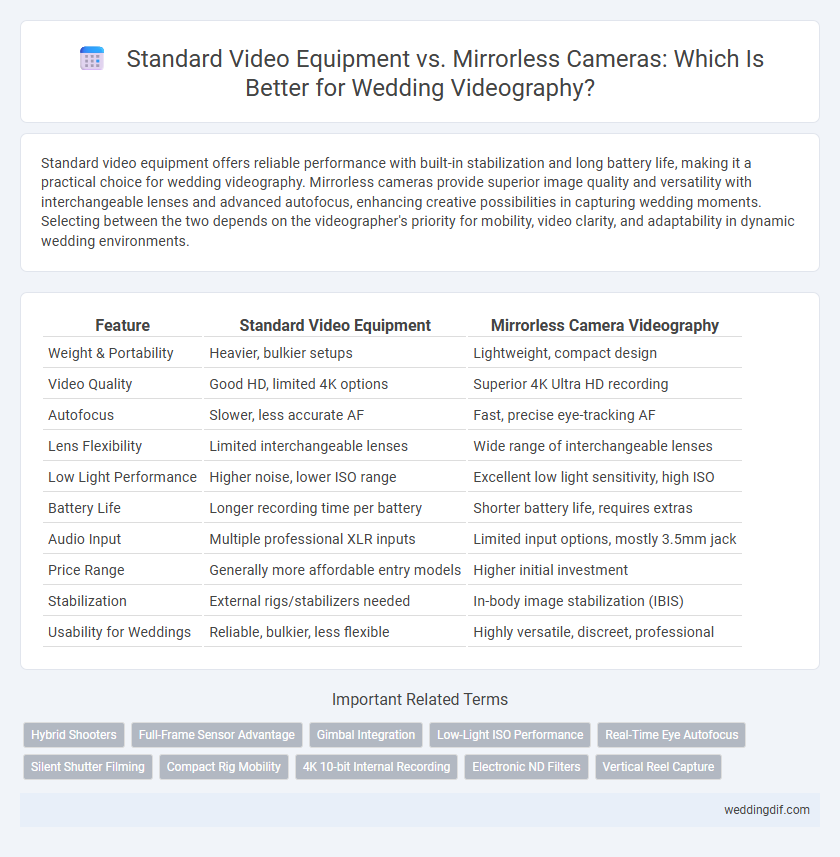Standard video equipment offers reliable performance with built-in stabilization and long battery life, making it a practical choice for wedding videography. Mirrorless cameras provide superior image quality and versatility with interchangeable lenses and advanced autofocus, enhancing creative possibilities in capturing wedding moments. Selecting between the two depends on the videographer's priority for mobility, video clarity, and adaptability in dynamic wedding environments.
Table of Comparison
| Feature | Standard Video Equipment | Mirrorless Camera Videography |
|---|---|---|
| Weight & Portability | Heavier, bulkier setups | Lightweight, compact design |
| Video Quality | Good HD, limited 4K options | Superior 4K Ultra HD recording |
| Autofocus | Slower, less accurate AF | Fast, precise eye-tracking AF |
| Lens Flexibility | Limited interchangeable lenses | Wide range of interchangeable lenses |
| Low Light Performance | Higher noise, lower ISO range | Excellent low light sensitivity, high ISO |
| Battery Life | Longer recording time per battery | Shorter battery life, requires extras |
| Audio Input | Multiple professional XLR inputs | Limited input options, mostly 3.5mm jack |
| Price Range | Generally more affordable entry models | Higher initial investment |
| Stabilization | External rigs/stabilizers needed | In-body image stabilization (IBIS) |
| Usability for Weddings | Reliable, bulkier, less flexible | Highly versatile, discreet, professional |
Introduction to Wedding Videography Equipment
Wedding videography equipment traditionally centers around standard video cameras prized for their reliability, in-built stabilization, and ease of use during extended shoots. Mirrorless cameras are increasingly favored for their compact size, superior image quality, and interchangeable lenses, allowing for creative flexibility and high-resolution storytelling. Choosing between standard video equipment and mirrorless cameras impacts final video aesthetics, operator comfort, and adaptability to various lighting conditions and shooting environments.
Overview of Standard Video Equipment
Standard video equipment for wedding videography typically includes DSLR cameras, camcorders, and external microphones, providing reliable performance and ease of use. These systems offer solid battery life, optical zoom, and straightforward controls, making them suitable for capturing long events without frequent interruptions. While they may lack the advanced video features and compact size of mirrorless cameras, standard equipment remains a cost-effective choice for consistent, high-quality wedding footage.
Rise of Mirrorless Cameras in Wedding Videography
Mirrorless cameras have revolutionized wedding videography by offering lightweight bodies, advanced autofocus systems, and superior low-light performance compared to traditional standard video equipment. Their compact form factor allows videographers to capture candid moments more discreetly, enhancing the natural storytelling aspect of wedding films. Increasing sensor technology and lens compatibility make mirrorless systems the preferred choice for modern wedding professionals seeking high-quality, versatile videography tools.
Video Quality: Standard vs. Mirrorless
Standard video equipment often relies on larger sensors and traditional optics that provide consistent color profiles but may struggle in low-light wedding venues. Mirrorless cameras feature advanced sensor technology and faster autofocus systems, delivering superior video quality with enhanced dynamic range and detail in challenging lighting conditions. For capturing weddings, mirrorless videography ensures crisp, vibrant footage that adapts seamlessly to varying environments, surpassing many standard video cameras in image fidelity.
Portability and Ease of Use
Mirrorless cameras offer superior portability and ease of use compared to standard video equipment, making them highly suitable for dynamic wedding environments. Their compact size and lightweight design allow videographers to move swiftly between scenes without fatigue, enhancing coverage flexibility. Advanced autofocus systems and intuitive controls further streamline shooting, ensuring high-quality footage with minimal setup time.
Low Light Performance Comparison
Mirrorless cameras excel in low light performance for wedding videography due to their larger sensors and advanced image stabilization, capturing clearer details and reducing noise compared to standard video equipment. Standard camcorders often rely on smaller sensors and less sophisticated optics, resulting in grainier footage and limited dynamic range in dim environments. Choosing a mirrorless camera enhances the quality of night or indoor wedding shoots, providing richer colors and sharper imagery critical for preserving precious moments.
Audio Capabilities and Accessories
Standard video equipment for wedding videography often features built-in microphones and supports professional audio inputs like XLR, ensuring high-quality sound capture crucial for vows and speeches. Mirrorless cameras, while compact and versatile, typically require external audio recorders or adapters to achieve comparable audio quality, relying heavily on accessories such as shotgun microphones and wireless lavalier systems. Investing in quality audio accessories is essential for mirrorless setups to overcome their inherent audio limitations and deliver crisp, clear wedding audio.
Creative Flexibility for Wedding Cinematics
Mirrorless cameras offer superior creative flexibility for wedding cinematics due to their compact size, interchangeable lenses, and advanced autofocus capabilities, allowing videographers to capture dynamic angles and intimate moments effortlessly. Standard video equipment often lacks the versatility and lightweight design necessary for spontaneous, cinematic storytelling, limiting creative expression during fast-paced wedding events. The ability to shoot in diverse lighting conditions with mirrorless cameras further enhances the aesthetic quality and emotional impact of wedding films.
Cost Considerations for Videographers
Standard video equipment for wedding videography often involves higher initial costs due to bulky camcorders and multiple accessories, whereas mirrorless cameras typically offer a more budget-friendly option with versatile lens compatibility. Mirrorless cameras provide excellent image quality and portability, reducing the need for extensive gear investment and lowering overall production expenses. Cost considerations for videographers include not only equipment price but also maintenance, storage, and ease of transport, where mirrorless systems generally offer greater long-term affordability.
Choosing the Right Gear for Your Wedding Style
Standard video equipment offers robust performance with larger sensors and optical zoom capabilities, ideal for capturing classic, high-quality wedding footage in diverse lighting conditions. Mirrorless cameras provide advanced autofocus, lightweight design, and interchangeable lenses, allowing more creative flexibility and discreet shooting during intimate moments. Selecting gear depends on whether you prioritize stability and traditional aesthetics or prefer mobility and modern features to match your unique wedding style.
Standard Video Equipment vs Mirrorless Camera Videography for weddings. Infographic

 weddingdif.com
weddingdif.com